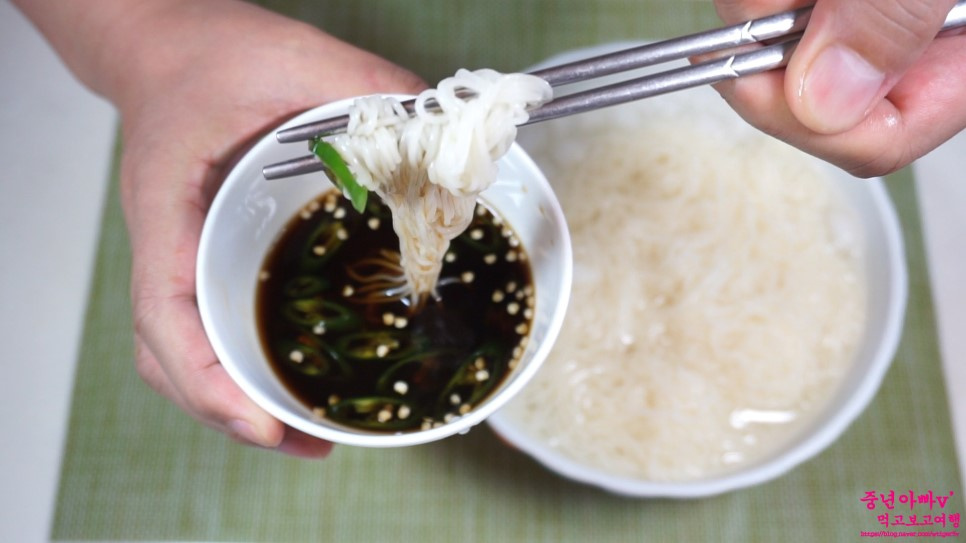Choi Hwa-jung’s Soy Sauce Noodles with Tsuyu
[Bap Bless You Soy Sauce Noodle Recipe] Lee Young-ja Approved, Choi Hwa-jung’s Tsuyu Soy Sauce Noodle Recipe to Beat the Summer Heat!

Yesterday, I meticulously prepared my own tsuyu. The reason? To make Choi Hwa-jung’s famous Tsuyu Soy Sauce Noodles, which Lee Young-ja, Song Eun-yi, and Kim Sook all raved about on ‘Bap Bless You’! My homemade tsuyu is less salty than store-bought versions, making it perfect for kids. The recipe involves soaking the noodles generously in the tsuyu sauce for a deeper flavor. The single slice of Cheongyang pepper, a signature touch from Choi Hwa-jung’s recipe, is truly a stroke of genius. This recipe is perfect for a refreshing summer meal. Tsuyu recipe: @6892511
Ingredients (1-2 Servings)- Somen noodles (or thin noodles) for 1-2 servings
- 1 Cheongyang pepper
- 1/2 cup Tsuyu soy sauce (approx. 100ml)
- 1/2 cup Water (approx. 100ml)
Cooking Instructions
Step 1
Let’s explore the different types of noodles based on their thickness and characteristics.
– Jungmyeon (Medium Noodles): These have a thicker, less sticky texture and are ideal for noodle soups where broth is added. Many famous anchovy noodle restaurants use this type.
– Somen: This is the noodle most people typically imagine when they hear ‘noodles’. Its chewy texture makes it versatile for both brothy soups and cold mixed noodles, offering a safe and enjoyable option.
– Semyeon (Thin Noodles): The thinnest and chewiest among the three, it’s primarily suited for cold mixed noodles.

Step 2
From left to right, we have Jungmyeon, Somen, and Semyeon. Can you tell the difference in thickness just by looking? If you zoom in on the photo, the difference in thickness becomes much clearer. The contrast between Jungmyeon and Semyeon is particularly noticeable.

Step 3
It’s often puzzling how much to cook for one serving, isn’t it? If you check the back of the noodle packaging, there’s usually a diagram showing a circle filled with noodles that represents one serving. Measuring out one portion is not difficult with this guide.

Step 4
Here are the ingredients for today’s dish. I’ve brought out the tsuyu I made yesterday, and I’ve chosen Semyeon noodles to better appreciate the tsuyu sauce’s flavor. One Cheongyang pepper should provide just the right amount of heat. I’ve measured out 100ml of tsuyu soy sauce and 100ml of water (which is about half a paper cup for each).

Step 5
Mix the tsuyu soy sauce and water in a 1:1 ratio. Since the tsuyu I made is less salty, a 1:1 ratio works well for me. However, the saltiness varies greatly between store-bought tsuyu and mentsuyu (soba dipping sauce), so it’s best to taste as you mix and adjust the water accordingly. Add water little by little until you reach your desired taste.

Step 6
Cut the Cheongyang pepper diagonally into large pieces. If you chop it too finely, you might end up with too much heat or find it difficult to eat with the noodles. Slicing it thickly, as shown in the photo, allows you to enjoy a piece of the peppery flavor with each bite.

Step 7
1. Bring a generous amount of water to a rolling boil before adding the noodles.
2. Give the noodles a gentle stir once they’re in the water to prevent sticking.
3. When the water starts to boil up, add half a cup of cold water and stir again. (Adding cold water helps make the noodles chewier.)
4. Once it boils up again, add another half cup of cold water and stir.
5. When the water boils vigorously for the third time, turn off the heat. The noodles are now cooked. Rinse the cooked noodles thoroughly under cold running water, rubbing them like laundry, to remove excess starch.

Step 8
Rinse the noodles and then place them in ice-cold water. This ensures they are thoroughly chilled for a refreshing experience. Having ice cubes floating in the water will keep the noodles perfectly cool.

Step 9
Add the chilled noodles to the prepared tsuyu sauce and stir well to ensure the noodles absorb the delicious sauce.

Step 10
Here’s the beautifully plated Tsuyu Soy Sauce Noodles, ready to be enjoyed with the dipping sauce.

Step 11
You can either dip the noodles into the tsuyu sauce or let them soak in the sauce for a richer flavor.

Step 12
Because the sauce is made with a milder flavor, soaking the noodles generously doesn’t result in excessive saltiness. These chilled noodles are a perfect summer treat. They offer a unique flavor profile distinct from soba noodles. Don’t forget to slurp them up for the full experience!

Step 13
The diagonally sliced Cheongyang pepper is the ‘stroke of genius’ in this recipe. Its sharp, spicy kick beautifully complements the savory tsuyu sauce, creating an explosion of flavor in your mouth. This is my first time trying noodles dipped with Cheongyang pepper, and this combination is absolutely fantastic. It transforms a simple mixture of soy sauce and water into a sophisticated and complete dish.




